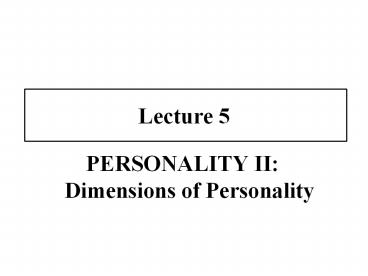PERSONALITY II: Dimensions of Personality - PowerPoint PPT Presentation
1 / 17
Title:
PERSONALITY II: Dimensions of Personality
Description:
Cognitive Style (and the Myers-Briggs Type Indicator) The ... traits: sociability, gregarious, assertive, talkative, active. emotional stability (neuroticism) ... – PowerPoint PPT presentation
Number of Views:1264
Avg rating:3.0/5.0
Title: PERSONALITY II: Dimensions of Personality
1
Lecture 5
- PERSONALITY II Dimensions of Personality
2
Class Outline
- Lecture - the various dimensions of personality
- Exercise What is your type? The Myers-Briggs
Type Indicator (MBTI) - complete the survey and score it
- exploring types
- video (15 minutes - if we have time)
- So what?
3
Dimensions of Personality
- The Big Five Model
- Cognitive Style (and the Myers-Briggs Type
Indicator)
4
The Big Five Model of Personality
- Directed at the work place
- Five dimensions of personality
- Extroversion
- Emotional Adjustment
- Agreeableness
- Conscientiousness
- Intellect/openness to experience
5
The BIG FIVE Personality Dimensions
- extraversion/introversion
- traits sociability, gregarious, assertive,
talkative, active - emotional stability (neuroticism)
- traits anxious, depressed, angry, emotional,
insecure - agreeableness (likeability)
- traits courteous, flexible, trusting,
cooperative - conscientiousness (conformity dependability)
- traits dependability, careful, thorough,
responsible - intellect (openness to experience)
- traits imaginative, cultured, curious, original,
broad-minded
6
Evidence
- conscientiousness predicts performance for all
occupational groups - extroversion predicts performance for managers
and sales representatives - openness to experience and extroversion predict
success in training
7
Cognitive Style
- Carl Jungs proposal
- individuals have different preferences for how
they approach the world, acquire information,
process information, and make decisions - Four sets of preferences (dimensions)
- each with two opposite poles
- individuals vary along each of the four
- gives 16 possible personality types
8
Cognitive Style (cont.)
- Four Dimensions
- Introvert vs. Extrovert
- (inner v. outer world)
- Thinking vs. Feeling
- (logic v. subjective view)
- Sensing vs. Intuiting
- (detail v. broad focus)
- Judging vs. Perceiving
- (resolution v. flexibility)
9
Orientation to the world Extraversion vs.
Introversion
- Extraversion - preference for
- action and interaction over reflection
- talking things over with others to gain
understanding - oral communication
- taking the initiative in social and work settings
- getting involved in social activities to
re-energize
10
Orientation to the world Introversion vs.
Extraversion
- Introversion - a preference for
- reflection over action
- thinking things through to gain understanding
- written communication rather than oral
- working alone or with one or two others
- spending time alone in order to re-energize
11
Acquiring information Sensing vs. Intuition
- Sensing - a preference for
- gathering facts and details
- focussing on information from the five senses
- an orientation to the present rather than the
future - being patient with routine tasks but less patient
with complexity - concentration on specific details of a task or
problem rather than the big picture
12
Acquiring information Intuition vs. Sensing
- Intuition - a preference for
- looking for patterns and relationships
- focussing on what lies beyond the surface
- an orientation towards the future rather than the
here and now - being patient with complexity but less patient
with routine - concentrating on the big picture rather than the
details
13
Processing information Thinking vs. Feeling
- Thinking - a preference for
- basing decisions upon logical analysis and cause
and effect reasoning rather than personal values
and beliefs - being analytical
- being perceived as reasonable by others
- wanting things to be fair even at the expense of
harmony
14
Processing information Feeling vs. Thinking
- Feeling - a preference for
- Basing decisions upon personal values and beliefs
rather than logical analysis - being sympathetic rather than analytical
- being perceived as compassionate
- wanting a harmonious outcome even at the expense
of equity and fairness
15
Decision making Judging vs. Perceiving
- Judging - a preference for
- making decisions and obtaining closure
- being systematic and keeping to a schedule
- completing one project before starting another
- committing to plans or decisions swiftly
- Finishing tasks before deadlines
16
Decision making Perceiving vs. Judging
- Judging - a preference for
- taking in all available information before
deciding - being spontaneous and casual
- working on multiple projects simultaneously
- being flexible, keeping options open
- finishing tasks at deadline
17
The Myers-Briggs Type Indicator
- Measurement of four dimensions giving 16 possible
cognitive styles (e.g. INTP, ESFJ etc.) - Aid for improving work team functioning
- Remember, no one type is ideal or best
- Even people who are the same type are different
- there are many other dimensions of personality - The MBTI only measures preferences not abilities
or aptitudes.































